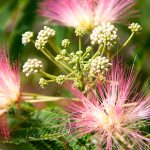Kapok fibre is the main product from this the silk-cotton tree. It is a downy material that surrounds the seeds. kapok is eight times lighter than cotton. A single tree produces 300 to 400 pods every year yielding up to 20kg or 44lb of kapok from its fifth year onwards. A tree can be expected to be in production for 60 years.
The plant is known scientifically as Ceiba pentandra or Bombax pentandra and is in the Bombacaceae family.
The plant also produces a red-brown gum that behaves like tragacanth (Astragalus gummifer).
Uses Of Silk-Cotton Tree
The leaves, bark, seeds and gum are all used.
The extracts act as an astringent diuretic to lower fever, relax spasms and control bleeding.
The seeds are toxic but the oil is edible and a useful adjunct in cuisine.
In medicine, it is used internally to control abnormal uterine bleeding, dysentry, diarrhoea in children by administering a gum, relieving bronchial congestion (use of bark and leaves). Its external applications include addition to baths to relieve fevers, headaches (bark and leaves), and as a poultice for erysipelas, the leaves are used to treat sprains and for treating wounds using the bark.
Commercially, kapok is an accoustic insulator and used in lifebelts. the seeds are converted into cattle cake.
Cultivation Of Silk-Cotton Tree
The crop is tender and so grown only in frost-free areas. the soil must be deep, rich and moist retentive. The tree is damaged by the wind and needs protection.
Seeds are propagated by cutting branches, or ‘post cuttings’, 1.2 – 2m (4-6ft.) long, which are spaced about 3m (10ft.) apart in the open ground. They also be inserted closer together and used as poles for the cultivation of Piper spp. Prune pot-grown plants to shape in spring.
Harvest
Leaves are picked during the growing season and used fresh or dried in infusions and poultices. Wood is cut in the dry season “when spirits are absent” and bark removed for decoctions. Gum is collected from incisions in young trees, made as the sap is rising at the end of the dry season. Fruits are collected when ripe and are dried before removal of the seeds, separtaion of the fibre, and processing for kapok.

I was looking out for the Persian silk tree but this is an interesting example of the sort of tree I want in my garden. I live in Aldershot so I’m hoping it will survive outside.